We know what you’re thinking. We had the same thought. When we read about Torotoro we assumed we would see a vague image of what could have possibly been a dinosaur footprint. What we saw though were undisputable, millions of years old dinosaur footprints.
High in the mountains above Cochabamba, is a fascinating national park with a surreal landscape. From dramatic canyons and caves to dinosaur footprints and turtle fossils, Torotoro National Park is a must see. The bizarre landscape we see today was formed by eons of wind and glacier erosion.


There are a few different tours offered in the park, and the only way to visit any site in the park is with a guided tour. We did three tours: El Vegel, The Cave Tour which includes Ciudad de Itas & Cueva Unijalanta, and The Turtle Graveyard. Dinosaur footprints can be seen on many of the tours.
El Vegel & Torotoro Canyon Mirador
To reach the canyon lookout we hiked along a dry creek bed. At one point we even had to scale down a dry waterfall. Looking back up the muli-layered rock made us realize that it must be amazing during rainy season when it is a waterfall.

The dry creek bed led us to the Torotoro Canyon lookout where the view of the canyon will take your breath away. Tall, vertical canyon walls zigzag their way into the distance. One wall overlaps the next making the narrow canyon appear as if it is enclosed within itself. Unfortunately, the sky was overcast so our pictures don’t capture its true colours.
The canyon walls seem to go down forever to reach the river far below. Nestled in these walls are bird nests of the endangered red-fronted macaws. We heard and saw a few flying to and from the canyon walls.




From another mirador further up the trail, the canyon revealed to us an even more stunning side.

There are over 900 steps to reach the canyon floor, 300 meters below. Once at the bottom a short trail climbs between boulders and over large rocks as it follows the small river.

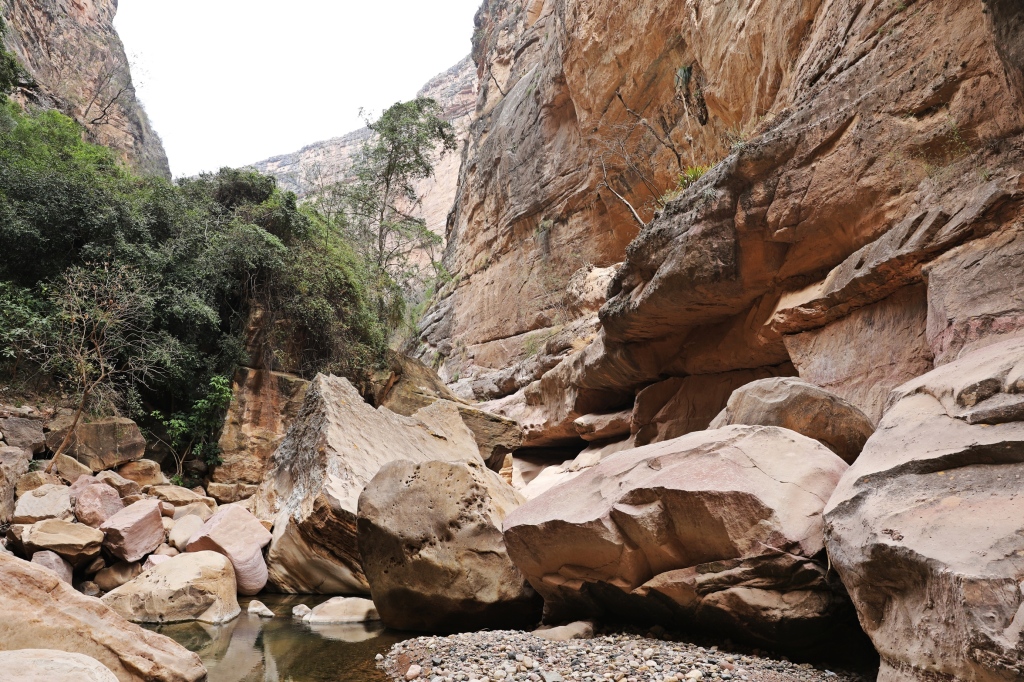


The walk brought us to the pretty El Vegel Waterfall. The falls are spread over a cliff face which is covered in vegetation. Water looks as if it is seeping from the canyon wall as it falls into a small pond below. Even near the end of dry season there was still enough water to make it a nice spot. During rainy season the water falls all the way from the canyon top. It would be an amazing sight but unfortunately during this time there is too much water in the river so you can’t walk on the canyon floor to see it.



Ciudad de Itas (City of Rocks)
This 4 kilometer walking tour takes you through the otherworldly landscape that make up much of the park. It begins by walking through desert-like terrain filled with cacti and small bushes growing between large karst boulders and cliffs. Hiding on top of some rocks were cute vizachas.






There are several viewpoints along the trail that allow you to see the amazing karst landscapes of Torotoro.


As we continued walking the ground changed. Instead of walking on a dirt trail surrounded by rocks we were moving across a large flat rock. In the middle of it we found a large cleft in the rock. Bordered by sheer cliffs the canyon, although small, is stunning.

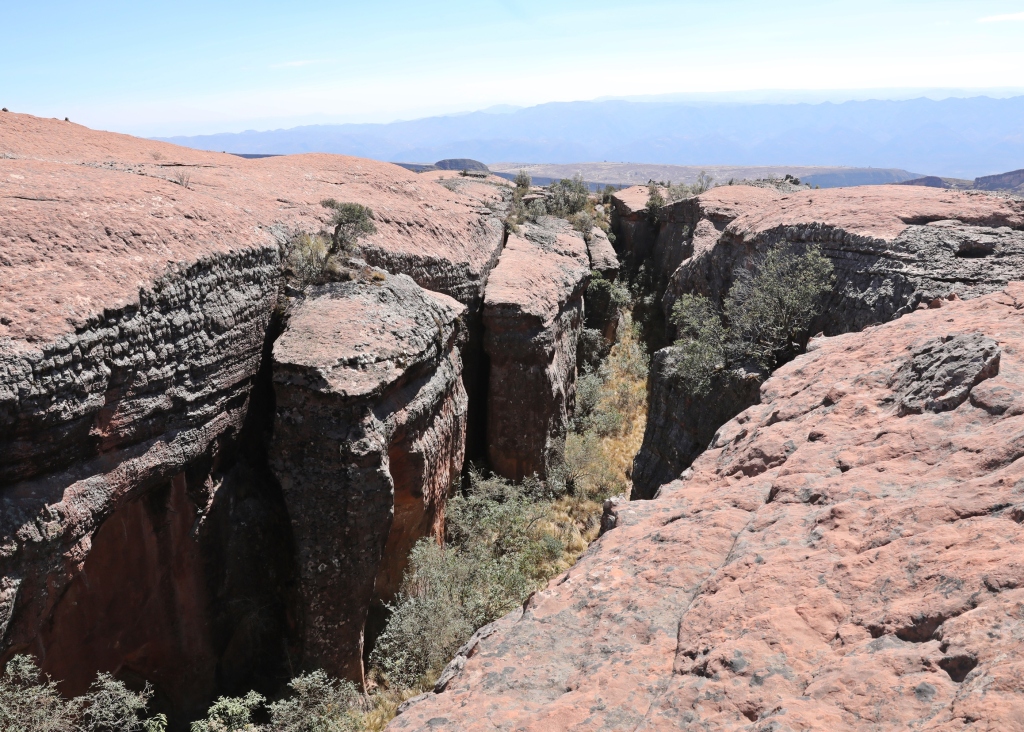

It didn’t seem like there would be a passage down when all of a sudden our guide disappeared over the canyon wall. He called for us to follow him down a natural staircase of boulders and broken stones.
On the canyon floor we walked through tight passages to find colourful caves. One cave is called the Cathedral. It has a small entrance but opens up into a large cathedral-like room with tall walls. Precariously covering its top is a large stone nicknamed ‘The Inca’. Our guide said it will likely crack and collapse in the next 80 years.
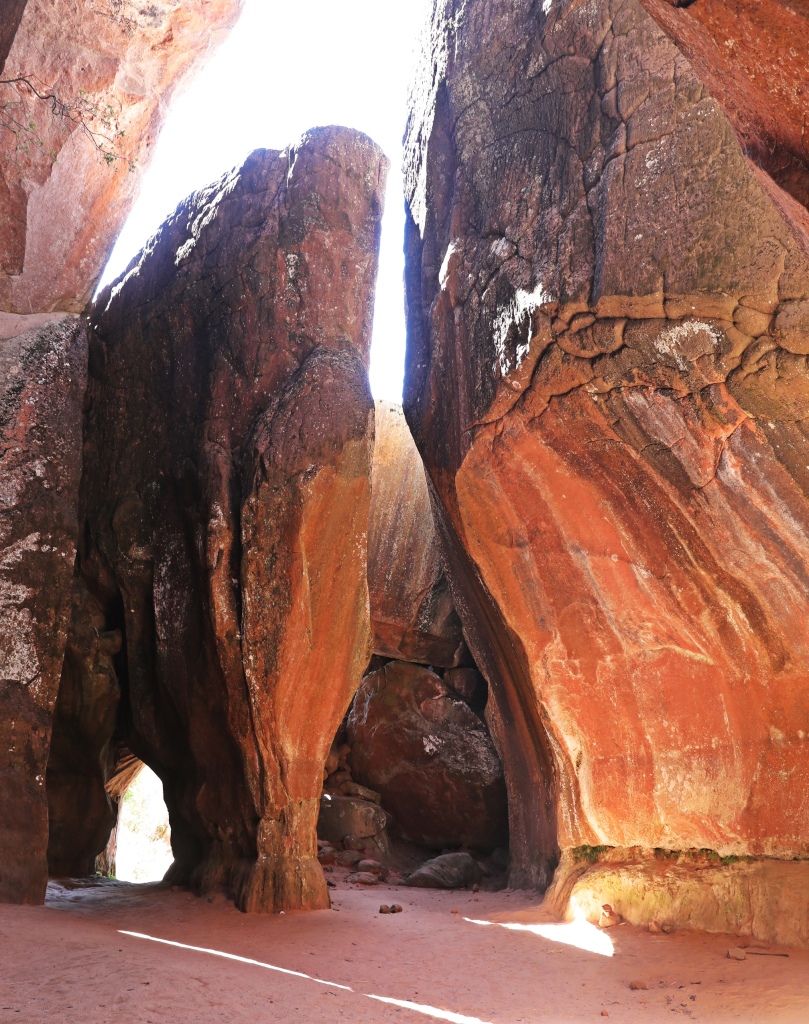


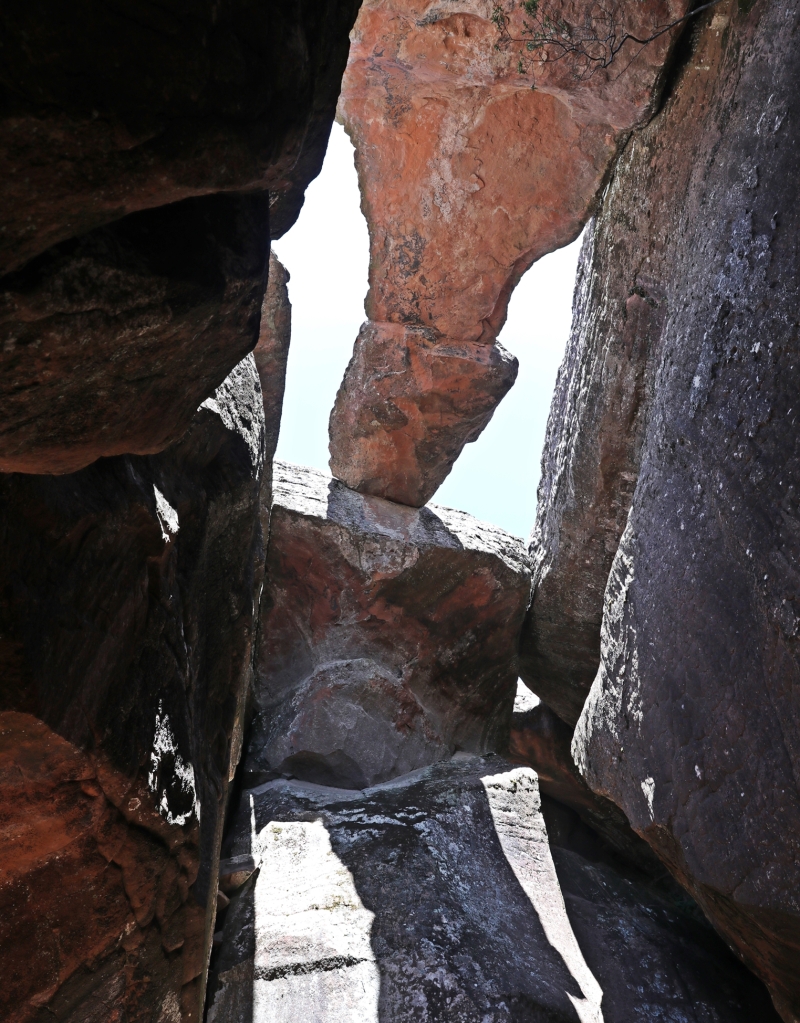
Cueva Umajalanta (Cave of Lost Water)
We donned helmets and headlamps and entered the small entrance to Cueva Umajalanta. It was quite an adventure to make our way through the cave. First we crossed over large boulders at the cave’s entrance. Inside the cave we had to crawl on all fours between, under and through small squeeze passages and tunnels. At one point the only way to fit through was to lie on the ground sideways and squirm your way along the sandy bottom. It was so narrow, we even had to pass the camera through separately. This is not a cave for claustrophobics.

There was a lot of climbing and rappelling with ropes and scrambling using your hands and feet. Some of the descents were so steep and slippery that we slid down on our feet or even our butts. There were places where we walked along narrow ridges with no protection from the steep drop offs. In the dark this became even more precarious.
These narrow passages lead to large cathedrals with tall stalagmites, stalactites and columns in many different shapes. The stalactites in Casa de Conceirto formed long rows that looked like a large pipe organ.

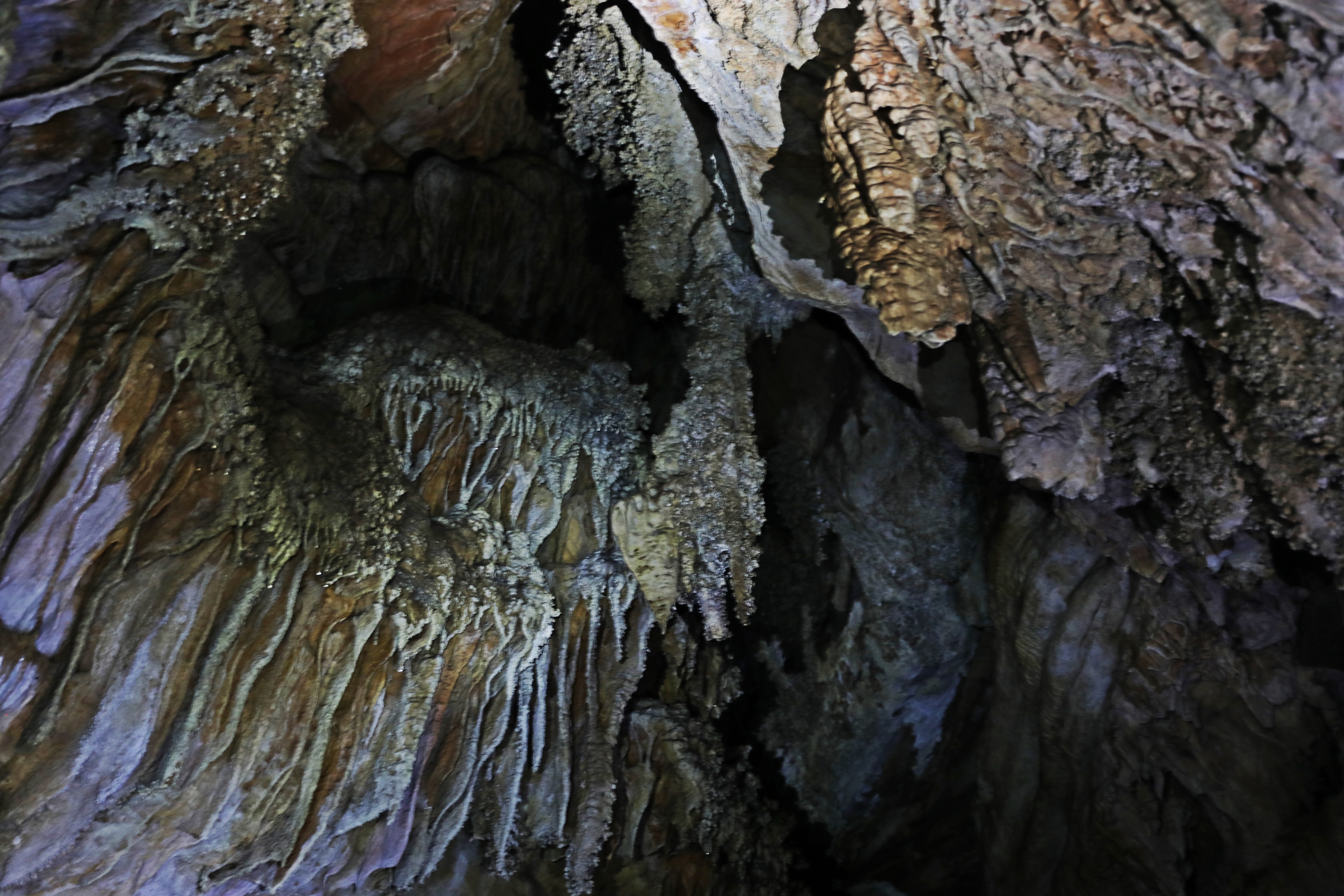
If we haven’t scared you with our description of the cave tour, then this is the tour for you. It was confined and dirty, but a lot of fun.
Dinosaur Footprints
During both tours, Cueva Unijalanta and El Vegel we stopped to see dinosaur footprints. Having read about them prior to the tour, we were very skeptical. We assumed that we would see random imprints that are difficult to make out. Boy were we wrong. First we saw a large, deep imprint in the shape of a massive bird foot. Carnivorous raptor-style dinosaurs were known to live in this area in the Cretaceous Period.
A little further on we were completely surprised when not only was there one lone footprint, but a long series of steps. We felt as if we could actually see this large raptor running along the ground. The footprints have been covered in sand so they are easier to see.


At another site we saw footprints of large herbivore dinosaurs. They were made by quadrupeds walking on what is now a hill, but at the time was flat. As you can see in animals today, some quadrupeds walk so that front and back feet on one side move at the same time. Others walk so that the back foot comes up to the front as they walk. We could actually see this in the different dinosaur footprints. Compare pictures 2 and 3 to see the different style of walking.



One set of prints were clearly those of a parent walking side by side with their baby. It was almost overwhelming to see these footprints from 80 – 140 million years ago.

There are a few theories on why there are so many footprints in this area, but the most common is that the ground was very muddy and dried quickly leaving the impressions. And then the ground was covered by a different soil, leaving the footprints buried. It was only in the last 50 years that erosion exposed these footprints. In total they have found over 3,500 footprints in Torotoro. Researchers suspect many more will become visible in the coming years.
Cemetario des Tortugas (Turtle Graveyard)
Once again we had low expectations for the turtle graveyard. We expected a couple of small, barely distinguishable turtle fossils in the ground. It’s no exaggeration to say we were pleasantly surprised. Appearing to be rising out of the ground were dozens if not hundreds of turtle fossils. From a distance they looked to be live, white turtles, lying on the ground. There were large adults, small babies; all sizes of marine turtle fossils could be seen in the bright red earth.
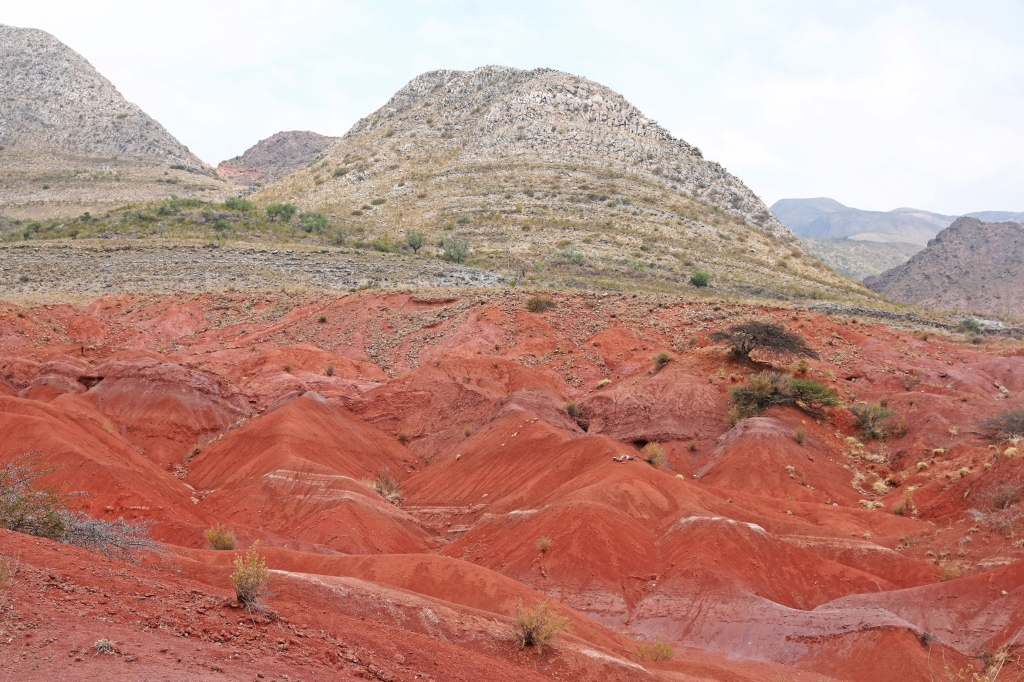




Millions of years ago this area was covered by the sea. Now due to ground erosion, the fossils are being exposed. In addition to turtles we saw two prehistoric crocodile fossils. The fossils in this area are from the Paleozoic period, 500 million years ago. It was absolutely mind boggling to see this in person.
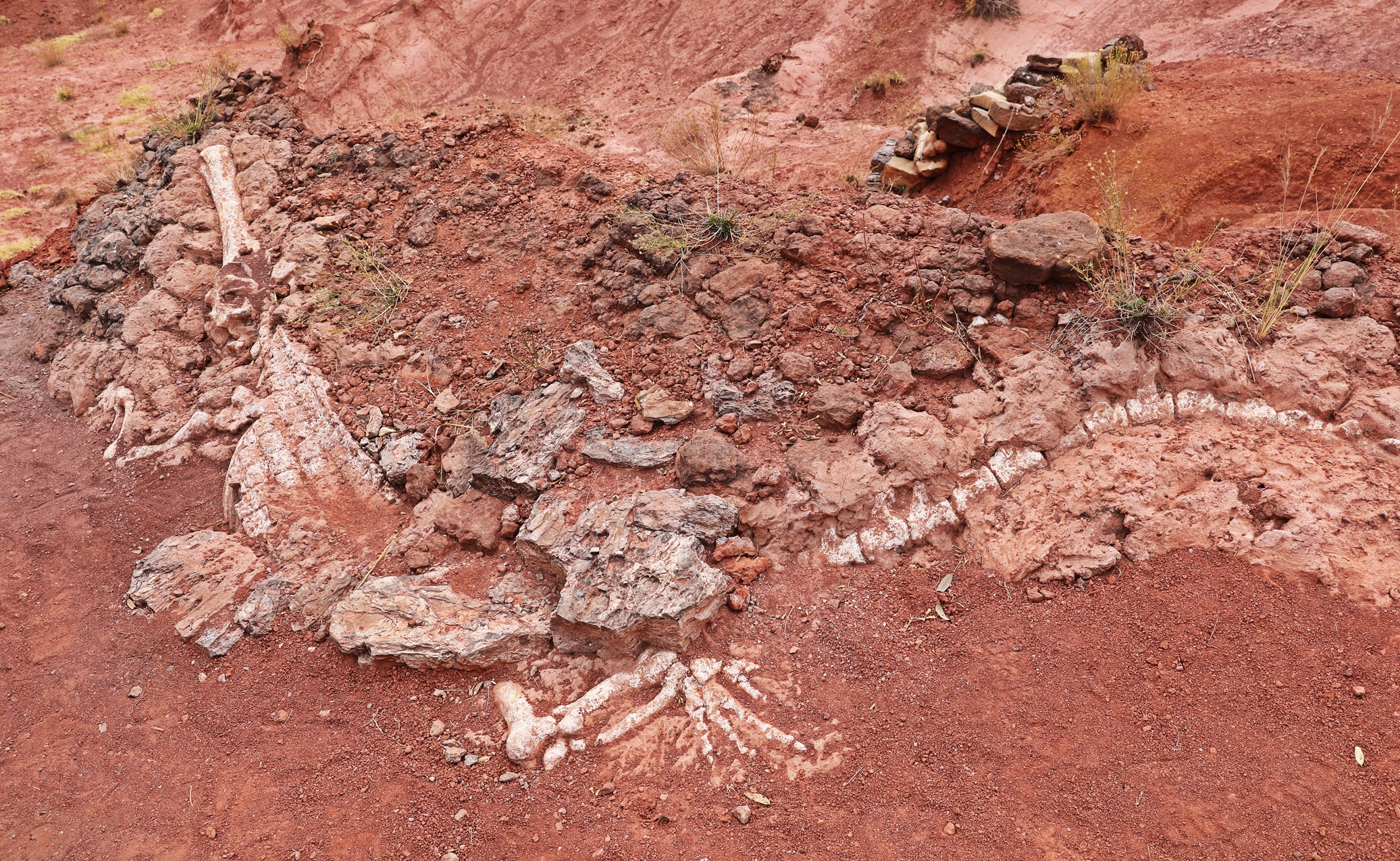
How to get to Torotoro
Even though it’s in Potosi Department, the only way to reach Torotoro is from the city of Cochabamba, 130 km away. Buses leave from the Central Bus Terminal, but they take up to 6 hours. We took a mini-bus from Av. Republica. They leave when they are full and take only 3-4 hours. On the drive to Torotoro our mini-bus made several stops in small towns along the way to pick up passengers in our already full bus. At one town a lady got on with her 3-day old baby goat! Something we will never experience back home in Canada.
Where to stay and eat
The small town of Torotoro is the only way to access the national park. In the fall of 2022 there were only a few hostels and hotels in operation. We stayed in Samarikuna Torotoro Hotel. It is a very nice hotel with spacious rooms, hot water and a lovely breakfast.
Not far from the National Park office is the main market and a few basic restaurants. We had surprisingly good pizza at the only pizza place in town.
Organizing a Tour
The National Park office is located in Torotoro town. You need to purchase a park pass which is valid for 4 days (100 Bolivianos per person). The only way to enter the park is with a guide. Their office is next door to the park office. All tours have a set fee which can be shared by up to 6 people. There are half and full day tours. The best way to find a group is to arrive at the guides’ office between 7 and 7:30 am. You can usually find others interested in the same tour.
To read about our other adventures in Bolivia click here.
Coming Next – Sucre, Bolivia’s Prettiest City
For pictures from other blogs go to Gallery at monkeystale.ca
To read about more of our adventures go to Destinations.
If you like what you read, please comment or share (with credit) using the links below
Excellent! This place was unfamiliar to me, so, I really appreciate seeing these photos and sharing your journey!!
LikeLiked by 1 person
Thanks! Glad we could introduce you to Torotoro 😊 Maggie
LikeLiked by 1 person
Me too! The place looks stunning! 🙂
LikeLike
Paleoarchaeology is such a fascinating topic. I appreciate these photos of footprints and fossils. The turtle remains kind of creeped me out, but in a good way. The canyon photos are amazing. This would be a great setting for a thoughtfully filmed science fiction movie of some sort.
LikeLiked by 2 people
It felt like we were on the set of a sci-fi movie like Juassic Park! 😊 I agree some of the Turtles were a little creepy. Maggie
LikeLiked by 1 person
Wow! What an amazing experience. Did you do it all in one day or take several days to complete all the tours? I’ve been in old mines as a fool-hardy teenager, going in ill equipped, but I don’t think I could manage the caves here. Stunning photos.
LikeLiked by 1 person
Thanks Katelon, One tour was a full day and the lookout and Turtles were done in one morning. The cave was one of the craziest cave tours we’ve ever done! It would not be pleasant if you have claustrophobia. Maggie
LikeLiked by 1 person
Absolutely amazing. It leaves one speechless. Or at least me speechless.
LikeLiked by 1 person
Us too, it is quite an unbelievable place. Thanks for coming up with some words 😊 Maggie
LikeLiked by 1 person
This is just about the most stunning travel blog post EVER! Everything about this is utterly fantastic – the caving, the bottom of the canyon, the views….but to end up seeing those incredible fossilised turtles and the dinosaur footprints , well, I’m almost speechless. Amazing, amazing stuff. Every single thing here is something we’d love to do, even the dark and claustrophobic caves (we’ve done some). Magnificent.
LikeLiked by 1 person
I can sense a trip to Bolivia in your future…. Honestly this is one of our favourite places in Bolivia. I’m glad the mystique of it came through. 😊
LikeLiked by 1 person
Oh this sounds so fund. I like dry arid places with reddish rock formations. I like the idea of just meeting up with others of similar interest for a tour group.
Great photos. The footprints are so fascinating. Imagine walking where pre-historic animals once lived…totally awesome. I really enjoyed your sharing as always. 😊
LikeLiked by 1 person
Thanks so much Suzette, it was almost an unbelievable experience. We kept expecting to find out we were on a movie set or something. 😊 Maggie
LikeLike
Excellent!!
LikeLike
Amazing! You certainly are lucky to have had the chance to go there.
LikeLiked by 1 person
Hi Bill, for some crazy WP reason this comment was in with the spam. We were so amazed by this park, and felt very fortunate to have been. Thanks for your comments 🙂 Maggie
LikeLiked by 1 person
Strange, but I was so amazed by that place and surprised that it exists, that I didn’t have much of import to say anyway.
LikeLiked by 1 person
Wow – what an amazing place.
We just saw three-toed dinosaur footprints similar to those in Croatia, but they were much fainter and less clear. Those footprints are incredible, and like you say, it’s overwhelming to peek back so many millions of years to a mother and baby walking side by side.
LikeLiked by 1 person
It was such a phenomenal thing to see, almost unbelievable! Thanks for commenting! Maggie
LikeLiked by 1 person
Wow, what an incredible place! Thank you so much for sharing it!
LikeLiked by 1 person
Thank you!
LikeLiked by 1 person
Spectacular and stupendous. Thanks for the tour of these beautiful sites.
LikeLiked by 1 person
Thank you! 😊
LikeLiked by 1 person
What an amazing and unique experiences that truly cannot be replicated anywhere else in the world. The Turtle graveyard and the dinosaur footprints are incredible, but everything else you did in this place is just as much. El Vegel waterfall is beautiful. The only thing I am not sure about doing is the Cave of Lost Water, sounds pretty hairy to me. Stunning, though.
LikeLiked by 1 person
It’s crazy how much there is to do in this one area, and all so different. The cave tour is definitely not for everyone. 😊 Thanks for your thoughts Leighton, Maggie
LikeLiked by 1 person
Stunning – and the fact that everything was left in a more or less natural state made them even more stunning, especially the turtle graveyard.
LikeLiked by 1 person
Yes exactly, everything is where it was found. It makes it even more special to know that a dinosaur was walking in the exact same spot. Thanks so much for sharing your thoughts. Maggie
LikeLike
Such an amazing experience! I enjoyed the read and loved the wonderful photos 🌺🌺🌺
LikeLiked by 1 person
Thank you Luisa! Maggie
LikeLiked by 1 person
You’re more than welcome, dearest Maggie 💙
LikeLike
A fascinating experience—one you’ll never forget
LikeLiked by 1 person
Very true 😊
LikeLiked by 1 person
How fascinating to see so many traces of dinosaurs! Especially the turtle graveyard- both amazing and also a little creepy.
LikeLiked by 1 person
Haha yes it was a little creepy, but I guess the name makes you expect that 😊 Thanks for uou comments Meg, Maggie
LikeLiked by 1 person
Good grief, how intrepid are you two? I couldn’t cope with the crawling through caves but the rest looks amazing. Awesome photos! And did you have to climb those 900 steps back out of that first canyon?
LikeLiked by 1 person
Yes we did have to climb 900 steps up too! At least it wasn’t at a very high elevation, and we had the canyon virmews to keep us distracted 😊
LikeLiked by 1 person
🤣💖
LikeLike
Looks breathtaking, especially the canyon and the Ciudad de Itas.
LikeLiked by 1 person
Thanks Ken, it is a beautiful part of Bolivia. Maggie
LikeLike
What amazing landscapes! The shapes of the turtles are so recognizable.
LikeLiked by 1 person
They looked like white turtles, it was incredible! Thanks for reading! Maggie
LikeLiked by 1 person
What a fascinating site to visit. The whole area has a very prehistoric look to it from the vegetation to the landscape itself and then of course the footprints which would have been so unbelievable to see. Love the mommy and baby prints! I think it is so cool that there are places like this still so well preserved. Makes you wonder what will be left a million years from now….hmmmmm
LikeLiked by 1 person
Yes it does, Maybe one day they find our foot and handprints in cement and be as shocked as we were 😊 Maggie
LikeLiked by 1 person
ohhhh now there’s a thought!
LikeLike
You find the most interesting places and have the best experiences; well done!
LikeLiked by 1 person
Well there are a lot of interesting places in Bolivia 😊 Thanks for reading!!! Maggie
LikeLiked by 1 person
Now I believe! 🙂
Impressive, those dino footprints. But I felt sorry for the poor turtle.
LikeLiked by 1 person
I know! The turtles looked like live white turtles from a distance. Thanks for adding your thoughts, Maggie
LikeLike
Wow, so many stunning captures, Maggie! To see the dinosaur footprints and the turtle/crocodile fossils would have boggled my mind too. Pretty amazing!!
LikeLiked by 1 person
Thank you Donna, there were so many stunning landscapes to capture. Maggie
LikeLiked by 1 person
What a wonderful place to walk. Love your photos of the fabulous landscapes. Cheers, Mark
LikeLiked by 1 person
It is! Thanks for reading! Maggie
LikeLike
OMG! I am packing my bags RIGHT NOW! I just can’t believe that country or your trip! Mel
LikeLiked by 1 person
I know! Bolivia has so many amazing places, we were blown away by it! Maggie
LikeLiked by 1 person
Torotoro National Park sounds fascinating. I love that you signed up for multiple tours to explore more of the rugged landscape and to see some of the dinosaur footprints. The cave sounds like a thrilling adventure! The turtle graveyard looks a bit eerie.
LikeLiked by 1 person
Yes the graveyard was a bit spooky, but I guess the name warns you 😊 The park though has so much to do and see, it was a great few days.
LikeLiked by 1 person
Looks a fabulous place to walk. Love your photos. Cheers, Mark
LikeLiked by 1 person
This is amazing! As I was reading, I was noticing some similarities in landscape to Dinosaur National Monument here in the US. But there aren’t any footprints here. Also, the Cueva Unijalanta tour sounds amazing!
LikeLiked by 1 person
Maybe some footprints will show up someday! Thanks for your comments. Maggie
LikeLiked by 1 person
Beautiful landscape. I have never heard of Torotoro National Park but with your post, now I do. Thanks for sharing, Maggie.
LikeLiked by 1 person
We hadn’t heard of it either until we started researching Bolivia. It was a great surprise! Thanks for you thoughts Arv, Maggie
LikeLike
This all sounds absolutely amazing – the canyon, the cave, and those fossils! Great post!
Alison
LikeLiked by 1 person
Thanks Alison, there was a lot to see and all of it was incredible! Maggie
LikeLiked by 1 person
Wow – this is amazing. I started out being stunned by the beauty of the waterfall on the El Vegel tour, but ended up stunned by the cave pictures/descriptions and the dinosaur prints and the turtle graveyard. What a find!
LikeLiked by 1 person
I know, we had pretty low expectations for all of it, but were blown away by everything!
LikeLike
This is a fascinating landscape – almost a mountainous desert. It must be amazing to, at first, be that high up to look down in the canyon … only to find yourself later inside that very same canyon! Great pictures – I especially liked those of the waterfalls coming down the cliffs.
LikeLike
Mind-boggling indeed! Another place we have not heard of. How did you discover this area? All the footprints are amazing. So many!
LikeLiked by 1 person
We met a couple who has family in Cochabamba and they told us to go to this park. I actually meant to tell you that if you go to Cochabamba you HAVE to go here. There were so many great things to see. And I really do recommend the hotel. They will make you dinner with advance notice.
LikeLiked by 1 person
Awesome. Thanks.
LikeLike
Even without the dino prints and turtle fossils, this post just reeks eons of time. The quality of the turtle fossils is mind blowing given their age. 500 million years ago? Seriously? (I doubt humans will survive 500 thousand years.)
LikeLiked by 1 person
I know, we were blown away by almost everything here. It felt like a movie set rather than reality! Thanks for reconnecting 🙂 Maggie
LikeLiked by 1 person
Amazing rock formations especially those caused by the wind. Thanks so much for sharing. I have not seen a red fronted Macaw nor that part of the world. Fascinating.
LikeLiked by 1 person
Thank you, it is a fascinating park. Thanks so much for reading and commenting on 😊 Maggie
LikeLiked by 1 person
The pleasure was mine, Maggie! Nice to meet you,
Amanda
LikeLiked by 1 person
Wow it’s absolutely amazing. Those turtles – it’s incredible how preserved they are!
LikeLiked by 1 person
I know it was amazing to see them. We had no idea this park would be so good! Thanks for reading Hannah!! Maggie
LikeLike
Wow Maggie the caves are truly incredible and love that macaw. The turtle graveyard is surreal! Thanks for sharing this! 💞
LikeLiked by 1 person
Thanks Cindy the entire park felt beyond reality 😊 Maggie
LikeLiked by 1 person
Oh my I can imagine. 💞
LikeLike
Wow, what an incredible trek! Besides the beauty of the canyon and waterfall, it was a bit scary to imagine the raptor, and the turtle bones in the red dirt. I couldn’t have done the cave.
LikeLiked by 1 person
The cave is definitely not for everyone 😊But seeing the dinosaur footprints and turtles was so amazing! Thanks for sharing your comments Ruth! Maggie
LikeLiked by 1 person
It’s great how blogs like this share what must have been an amazing experience. Beyond that it raised the awareness of what truly looks to be a special place with an amazing landscape – I honestly had to Google the location as would no doubt many.
An absolute classic example of how the lay of the land has been shaped by the forces of nature and is determined by its local geology and structures.
The pictures capture a moment of time that are windows into the deep time of a vast geochronological past where the lay of the land is determined by its local geology and structures. The layers in the rocks are literally akin to the pages & chapter in a book as each layer represents a period of deposition in the line of the sand that is geochronological time.
Thanks for sharing. A great post.
LikeLiked by 1 person
Thanks so much Chris, yes it’s set out so you can almost see each layer of history on top of each other . A fascinating landscape. Thanks for adding your insight. Maggie
LikeLiked by 1 person
just incredible! And such variation in vegetation! could be two or three different worlds!
LikeLiked by 1 person
I know it’s a crazy place. It felt like a movie set for Jurassic Park or something! Maggie
LikeLike